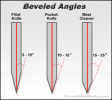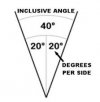Hi all.
When people talk about specific angles: 20 degree for example.
Say you have a knife with a Sabre grind.
Im assuming its 20 degrees in relation to the flat bit of the blade, before the the angle change. (Hope that question makes sense)
So having the spine verticle and tilting the knife 20 degree from that angle?
Same with a full flat grind, not going from the angle of the grind but from having the spine verticle?
Thank you =)
When people talk about specific angles: 20 degree for example.
Say you have a knife with a Sabre grind.
Im assuming its 20 degrees in relation to the flat bit of the blade, before the the angle change. (Hope that question makes sense)
So having the spine verticle and tilting the knife 20 degree from that angle?
Same with a full flat grind, not going from the angle of the grind but from having the spine verticle?
Thank you =)


